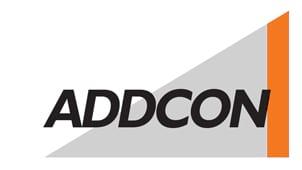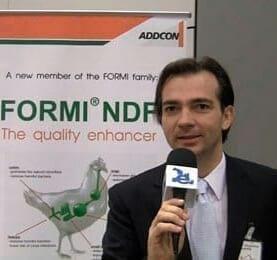Trojans tricking harmful bacteria
Published: January 1, 2002
By: Christian Lückstädt / Kurt Wegleitner
Addcon claims to have found a way to control Gram-positive bacteria.

Ever since the ban on in feed antibiotics in Europe, scientists have looked for ways to control harmful bacteria. By means of directly fed microbials, prebiotics which nurture beneficial bacteria, phytogenics or organic acids, this target can be achieved only partially. While it is possible to have a direct impact on Gram-negative bacteria, it is only possible to indirectly inhibit harmful Gram-positive bacteria.
In case of the Gram-negative bacteria, the undissociated part of organic acids can, due to their lipophilic nature, attach to the lipid components (e.g. phospholipids) of the cell membrane, migrate through it and by changing the pH of the cells mycoplasma inhibit the growth of the bacteria and leads therefore to a rapid cell death.
Gram-positive bacteria however, are naturally protected by an additional cell wall, consisting of multiple peptidoglycan layers. This natural “fire walls” protects the bacteria from acids to reach the cell membrane and thus acids cannot enter into the cell.

Addcon claims to have found “natural Trojans” which can find the weak spots of those peptidoglycan walls and allow their double salts to sneak through those loopholes. In an interview with Engormix, Dr. Christian Lückstädt and Kurt Wegleitner speak about the mode of action of their “3rd generation acidifiers” for the first time.
Engormix: Addcon speaks about Trojans in animal nutrition. While the historical context of Troy as well as the misuse of the concept in modern computer technique is well known, it is strange to hear about Trojans and animal nutrition.
 Kurt Wegleitner: First of all we know that we must replace antibiotics. It is a fact there will not be any future research done to find new, next generation antibiotics for animal husbandry. So, it was clear that we must find other means to control harmful bacteria, which we do by our “3rd generation acidifiers”. It is true that this is a very new concept. In fact, we have been trying to find a solution on how to control harmful Gram-positive bacteria for many years. The tipping point in the product development was an after work discussion with some veterinarians who suggested that “it is almost impossible to fight Gram-positive bacteria. Only a trick to get through the cell wall can bring success.” This is when we changed our thinking and started to look much closer into the cell wall as such.
Kurt Wegleitner: First of all we know that we must replace antibiotics. It is a fact there will not be any future research done to find new, next generation antibiotics for animal husbandry. So, it was clear that we must find other means to control harmful bacteria, which we do by our “3rd generation acidifiers”. It is true that this is a very new concept. In fact, we have been trying to find a solution on how to control harmful Gram-positive bacteria for many years. The tipping point in the product development was an after work discussion with some veterinarians who suggested that “it is almost impossible to fight Gram-positive bacteria. Only a trick to get through the cell wall can bring success.” This is when we changed our thinking and started to look much closer into the cell wall as such. Christian Lückstädt: Most feed additives can work on Gram-negative bacteria only. However, while the antimicrobial impact of organic acids and their salts, including Addcon’s patented diformates, is mainly directed against Gram-negative bacteria, medium chain fatty acids (C-6 to C-12) have been shown to have also an antibacterial impact against various Gram-positive bacteria. This is especially true for lauric acid (C-12) and its monoglyceride ester monolaurate. Lauric acid has the greatest antibacterial activity of all medium chain fatty acids. This effect is magnified if monolaurate is used, making it THE candidate as an additive or as an alternative to antibiotics for treatment of different diseases, caused by Gram-positive bacteria.
Christian Lückstädt: Most feed additives can work on Gram-negative bacteria only. However, while the antimicrobial impact of organic acids and their salts, including Addcon’s patented diformates, is mainly directed against Gram-negative bacteria, medium chain fatty acids (C-6 to C-12) have been shown to have also an antibacterial impact against various Gram-positive bacteria. This is especially true for lauric acid (C-12) and its monoglyceride ester monolaurate. Lauric acid has the greatest antibacterial activity of all medium chain fatty acids. This effect is magnified if monolaurate is used, making it THE candidate as an additive or as an alternative to antibiotics for treatment of different diseases, caused by Gram-positive bacteria.Kurt Wegleitner: in Addcon we do have a lot of knowledge about bacteria as we offer range of products to control harmful bacteria in the gut but also in feed and last but not least in silage. In the 1980s the first silage additives based on inoculants has been launched. The excellent contact with the research team from then was essential to understand the difference in the cell wall structure and possible mechanisms to change the game. “If you can´t beat ´em, join ´em” was slogan from then. We were surprised by the outcome in the project as in the end we actually “join ´em” by incorporating GML in the gram + bacteria´s cell wall.
Christian Lückstädt: I usually don’t like to talk about synergistic effects – as in most cases it is only and added effect, for instance when combining organic acids – but in case of the combination of diformates with medium chain fatty acids (MCFA) we really create, due to their different mode of actions such a synergistic impact. MCFA’s offer a perfect tool, in combination with the trusted diformate impact on the cell membrane of bacteria, to “open a door” in the cell wall structure of Gram-positive bacteria, such as Streptococci. So the 3rd generation is really a step ahead we are using Glycerin monolaurate as “a Trojan to the bacteria´s fire wall”
Kurt Wegleitner: Glyerin Monolaurate is one of the Trojans we are using in our 3rd generation acidifiers. GML acts as a friend to the gram+ bacteria and hence it is incorporated into the peptidoglycan “fire wall”. It creates a tunnel so that the acids can reach the cell and migrate through it. The rest is easy – the proven concept of how formic acid controls bacteria will get started.
Christian Lückstädt: Trials in Germany with a well-balanced combination of both concepts showed stunning results in sows and piglets. The data have and will be reported to the scientific community, but let me say already that much… we achieved reduction rates in the Streptococci count of sow faeces of more than 97%, enabling the suckling piglets to grow under much healthier conditions – and thus having a difference in weaning weight of around 500 g.
Kurt Wegleitner: Addcon has also gone a step further in exploiting the vulnerability of the cell membrane, with the development of further 3rd generation acidifiers. Formi Alpha and Addcon XL Forte are based on Addcon’s well known acid concept, combined with alkaloids and flavonoids from plant extracts, the so called “power plants”. These compounds also have well-described impacts against Gram-positive bacteria.
Christian Lückstädt: Cell research implies that that these “power plants” perturb the cell wall / cell membrane structure, creating an opportunity for organic acids to enter the cell. The flavonoids also disrupt the cell membrane’s ability to regulate its own proton balance, again leading the way for the organic acid’s hydrogen ions to disturb the cells internal pH: making a significant contribution to the severity of the antibacterial effect.
The two products have been launched in Europe and in the middle East already. Together with the launch in the market, Addcon is conducting numerous field studies in the various regions to prove its efficacy in real life conditions.
Related topics
Authors:
ADDCON
Phytobiotics
Influencers who recommended :
Christoph Hutter, DVM Stevan PetrovićRecommend
Comment
Share
ADDCON
11 de diciembre de 2017
Dear Mohamed, sorry for the late reply! Yes, the concept can be tested in aquaculture as well! Both active ingredients of the product... the diformate as well as the alkaloid part have demonstrated benefical impacts in fish, among them tilapia. The product would be available for testing in Egypt. Please contact me directly. Thank you!
Recommend
Reply
Recommend
Reply

Would you like to discuss another topic? Create a new post to engage with experts in the community.









.jpg&w=3840&q=75)